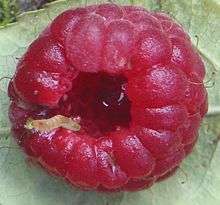Raspberry beetle
| Raspberry beetle | |
|---|---|
 | |
| Scientific classification | |
| Kingdom: | Animalia |
| Phylum: | Arthropoda |
| Class: | Insecta |
| Order: | Coleoptera |
| Family: | Byturidae |
| Genus: | Byturus |
| Species: | B. tomentosus |
| Binomial name | |
| Byturus tomentosus De Geer, 1774 | |
The raspberry beetle (Byturus tomentosus) is a species of beetle in the fruitworm family Byturidae. It is a pest that is widespread in north-central Europe, affecting raspberry, blackberry and loganberry plants. The beetles lay eggs on the flowers which hatch into pale brown larvae. The larvae feed on the developing fruit and cause the fruit to appear smaller and shriveled.[1] The raspberry beetle has to be controlled in many locations by use of derris, a pesticide. Although experts in ecological and organic growing no longer consider derris ecologically sound, Rotenone which is made from derris is still sold in the U.S.
This species is related to the raspberry fruitworm (B. urbanus) which is native to North America.
Economic significance

The pest damages both wild and cultivated raspberries and also blackberries. The beetles eat portions of the flowers and young leaflets and lay their eggs between the stamens and pistils. The larvae tunnel in the developing fruit which remain small, become pale in colour, fade or rot. The larvae then drop to the soil and pupate underground. Control measures include digging-over the soil around bushes and inter-row ploughing. Chemical pesticides may be applied at the flowering stage. White sticky traps are sometimes used to catch beetles.[1]
References
| Wikispecies has information related to: Raspberry beetle |